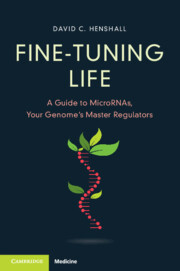Book contents
- Fine-Tuning Life
- Reviews
- Fine-Tuning Life
- Copyright page
- Dedication
- Contents
- Figures
- Ode to the MicroRNA
- Acknowledgements
- Common Terms and Definitions
- Introduction
- Chapter 1 Discovered!
- Chapter 2 MicroRNAs Emerge as Master Controllers
- Chapter 3 Epic Journey
- Chapter 4 Opening Act
- Chapter 5 MicroRNAs Shape the Machinery of Our Minds
- Chapter 6 Centre of the Electrical Storm
- Chapter 7 MicroRNAs Become Medicines
- Chapter 8 Circulating MicroRNAs Provide a Diagnosis
- Chapter 9 Finale and Encore for MicroRNAs
- References
- Index
Chapter 2 - MicroRNAs Emerge as Master Controllers
Published online by Cambridge University Press: aN Invalid Date NaN
- Fine-Tuning Life
- Reviews
- Fine-Tuning Life
- Copyright page
- Dedication
- Contents
- Figures
- Ode to the MicroRNA
- Acknowledgements
- Common Terms and Definitions
- Introduction
- Chapter 1 Discovered!
- Chapter 2 MicroRNAs Emerge as Master Controllers
- Chapter 3 Epic Journey
- Chapter 4 Opening Act
- Chapter 5 MicroRNAs Shape the Machinery of Our Minds
- Chapter 6 Centre of the Electrical Storm
- Chapter 7 MicroRNAs Become Medicines
- Chapter 8 Circulating MicroRNAs Provide a Diagnosis
- Chapter 9 Finale and Encore for MicroRNAs
- References
- Index
Summary
Seven years passed since the discovery of lin−4’s unique properties and then, around the turn of the millennium, the research floodgates opened. This chapter tracks the nascent field of microRNA research, the frenetic race to discover and catalogue new microRNAs and find the organisms in which they were made. MicroRNAs held a prominent position in evolution, their number and diversity expanding at key transitions to more complex life, including for our own species, Homo sapiens. MicroRNAs, it would become clear, are the genome’s solution to how to control the natural fluctuations, randomness and noise in gene expression. The chapter also covers the pivotal experiments that laid the ground rules for how microRNAs work and revealed their effects on gene expression. Along the way, a selection of the scientific toolkit gets special attention, including some of the models used to find microRNAs and the technologies that would prove that microRNAs, despite their small size and limited number in genomes, controlled the vast majority of gene activity in our cells.
Keywords
- Type
- Chapter
- Information
- Fine-Tuning LifeA Guide to MicroRNAs, Your Genome's Master Regulators, pp. 20 - 47Publisher: Cambridge University PressPrint publication year: 2024



